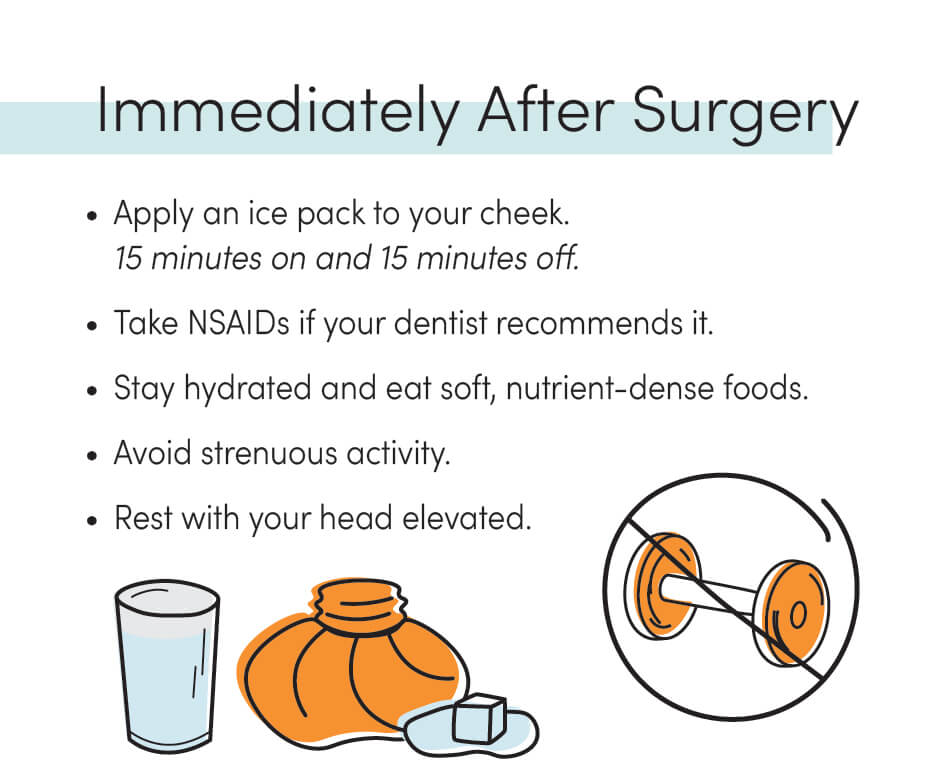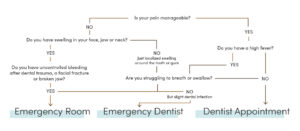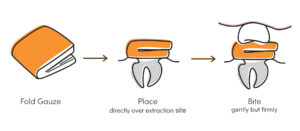How to Reduce Swelling After Wisdom Teeth Removal: Fast and Effective Solutions

Reviewed By Dr. Dennis Rollins, DDO |
July 2025 • 6 min Read
Reviewed By Dr. Dennis Rollins, DDO | July 2025 • 6 min Read
Some swelling is completely normal after getting your wisdom teeth removed, and there are simple ways to reduce it. Read on for what steps to take and how to tell if your healing is progressing normally.
What to Do After a Wisdom Teeth Removal
Immediately After Surgery (First 24 Hours)
- Apply an ice pack or a bag of frozen peas wrapped in a thin cloth to your cheek. Maintain a rhythm of 15 minutes on and 15 minutes off as much as you can while you’re awake. This will help numb pain while also reducing swelling.
- Keep your head elevated. When lying down, use extra pillows to keep your head above your heart. This will help limit fluid accumulation at the extraction site.
- Avoid strenuous activity, which increases blood pressure and circulation, potentially worsening swelling. Slow walks around the house are alright, but rest is best.
- Take ibuprofen, naproxen, or aspirin to help with inflammation, provided your dentist recommends it. Follow the dosing instructions carefully.
- Stay hydrated and eat soft, nutrient-dense foods, like soups, yogurt, mashed potatoes, and smoothies. Avoid hard, crunchy, and sticky foods.
After the First 24 Hours
- Apply a warm (not hot) washcloth or heating pad to your cheek. This improves blood flow, which helps the swelling go down faster.
- Gently exercise your jaw by opening and closing your mouth. This helps prevent stiffness and improves healing. That said, protect the surgical site by avoiding over-stretching. Stop if you feel pain, pulling, or pressure at the extraction site.
- Keep drinking water and eating soft, nutrient-dense foods.
- As long as you feel up to it, gradually increase physical activity—think walks around the neighborhood. Save rigorous exercise until day four or five.
Throughout Recovery
- Avoid smoking, as the suction, chemicals, and heat can dislodge blood clots, slow healing, and increase the risk of dry socket or infection.
- Avoid alcohol, which can irritate the surgical site, interfere with clot formation, slow healing, and interact dangerously with prescribed medications or antibiotics.
- Keep the surgical site clean by rinsing gently with warm salt water after the first 24 hours. This helps prevent infection.


Protecting Blood Clots
After a wisdom tooth extraction, your body will work to form a blood clot at each extraction site. This not only stops the bleeding but also forms the foundation for healing, facilitating the formation of new tissue and bone. Protecting this healing element is crucial.
This is why dentists recommend not using straws, cigarettes, or vape devices after an extraction. It’s also important not to rinse your mouth vigorously, spit forcefully, or hit the gym during your recovery. It’s equally important to leave the extraction site alone, as poking it can disturb that vital blood clot.
Your body wants to heal itself. Avoiding these activities help give it every chance to do just that.
Signs of Recovery
Use this timeline to ensure your recovery is progressing normally.
Surgery Day
- Swelling is usually minimal immediately after surgery.
- Some numbness may remain from anesthesia
- Mild puffiness may occur in the cheek.
Days 2–3
- Swelling typically peaks and starts to go down.
- Cheeks and jawline may still feel puffy, tight, or sore.
- Bruising can start to appear.
- Jaw stiffness is common.
Days 4–5
- Swelling continues to decrease.
- Discomfort and puffiness lessens each day.
- Bruising may darken or spread before fading.
Days 6–7
- Swelling is gone or much less pronounced.
- Some lingering puffiness might remain.
- Bruising starts to fade, leaving some yellow green coloration.
After 1 Week
- Most swelling has significantly resolved.
- Mild puffiness or stiffness may linger for up to two weeks.
When to Call Your Dentist
If you’re having difficulty swallowing or breathing, contact your dentist immediately.
For help finding a dentist in your area, click here or call us at (888) 597-3896.
While the vast majority of wisdom tooth removals heal normally, you should also contact your dentist if:
- You experience severe or increasing pain after three days, which could indicate a dry socket or infection.
- You notice bleeding beyond light oozing after 24 hours, which could mean that the blood clot has dislodged.
- Your swelling worsens instead of improving after three days, which may indicate an infection.
- You notice pus, a foul taste, or odor in your mouth, which often indicates an abscess or infection.
- You experience fever or chills, which can be a sign of a systemic infection.
- You notice persistent or spreading numbness, which may indicate nerve injury.
If none of these symptoms are present but you still have questions or concerns, don’t hesitate to call your dentist. Helping you navigate recovery is part of their job and expertise.
Food That Helps You Heal
Here are some dietary ideas to support your body’s natural healing process.
- Make a smoothie out of soft fruits like blueberries, strawberries, or bananas combined with yogurt or kefir. (Enjoy it without a straw!)
- Eat mashed avocado, which is high in healthy fats and helps fight inflammation.
- Indulge in applesauce, which is packed with antioxidants.
- Start the day with cooled oatmeal, which is gentle on your system and helps you feel full longer.
- Sip cooled chamomile tea, which has mild anti-inflammatory effects.
- Drink lots of water, which helps your body heal efficiently.
The Healing Power of Staying Calm
Having wisdom teeth removed can easily cause stress and anxiety. When you’re stressed, your body releases hormones like cortisol and adrenaline, which can increase inflammation and slow down healing.
Staying calm encourages your body to shift into repair mode, which lowers blood pressure, improves circulation, and helps your immune system function more efficiently. Relaxation also stops you from clenching your jaw or holding tension in your face, both of which can worsen swelling and discomfort.
Simple practices, such as deep breathing, listening to calming music or podcasts, and guided meditation, can help reduce stress while you recover. Keeping your mind relaxed gives your body the best chance to heal smoothly and quickly.
Need Help Finding a Dentist?
Related Information

How Much Is a Dentist Visit Without Insurance? Exact Costs Explained
Below, you’ll find a breakdown of typical out-of-pocket costs for common dental procedures, along with the reasons behind these costs. Keep in mind that these costs can vary significantly based on your location, the dentist’s experience, the materials used, and the complexity of the procedure.

Should You Go to the ER for Tooth Pain? A Quick Guide
Whether you should go to the ER for tooth pain depends on the severity of your pain and what other symptoms you’re experiencing. Read on for help deciding how to find relief.

How to Stop Bleeding After Tooth Extraction: Easy Tips for Immediate Relief
After a tooth extraction, some bleeding at the site is normal and will usually slow down within 2-3 hours. Gentle oozing (think pink saliva) will often continue for the first 24 hours. Below you’ll find tips for helping to stop the bleeding, and how to tell the difference between normal recovery and signs that you should call your dentist.
